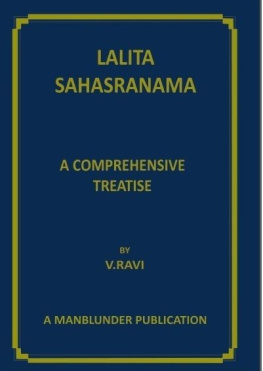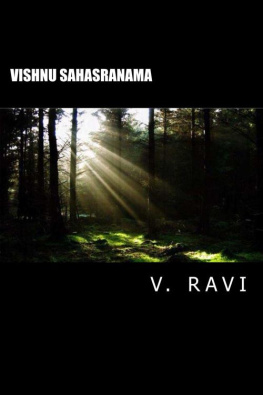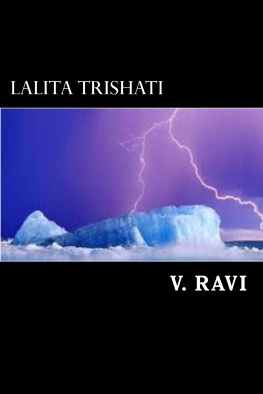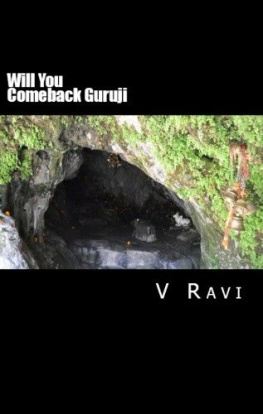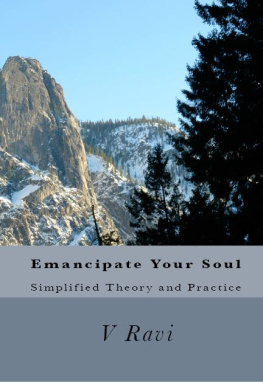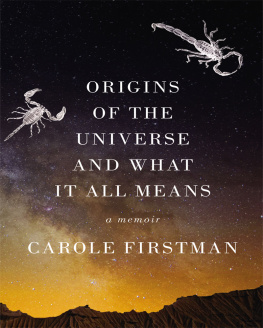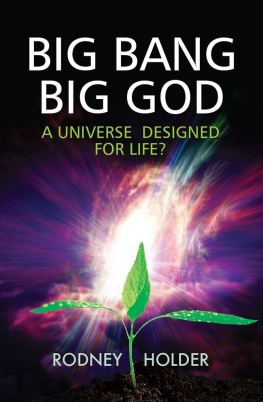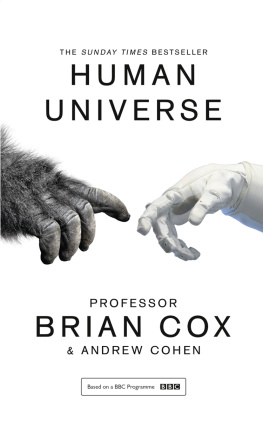LALIT SAHASRANMA

A COMPREHENSIVE TREATISE
BY
V. RAVI
A MANBLUNDER PUBLICATION
CHENNAI, INDIA
www.manblunder.com
Copyright with the author
All rights reserved. No part of this book may be reproduced, stored in retrieval system or transmitted, in any form or by any means, electronic, mechanical, photocopying, recording or otherwise without the written permission from the author, except for brief passages quoted in reviews or critical articles.
Published by: Manblunder Publication, Chennai, India.
PREFACE
Lalitmbik is the embodiment of compassion as She is fondly addressed as r Mt , which means the mother of the universe. She is fondly worshipped through many means such as worshipping r Cakra, meditating on Her through japa mantra -s such as Pacada and oda, singing Her praise through various verses, etc. The important among the last one is Her most celebrated Sahasranma, which was authored by Her very close attendants in Her presence and in Her place. Every name used in this Sahasranma has got gross and subtle meaning. Sahasra means one thousand and nma means name. Nma not merely refers to names, but also Her forms and attributes. She engulfs the universe through Her delusionary influence called my. iva has given Her full authority for effectively administering the universe.
This edition of Sahasranma contains detailed interpretation for each name with appropriate quotations from Veda-s, Saundarya Lahar, Bhagavad Gta, Upaniads, etc in order to make the understanding better. The citations from other Veda-s and scriptures go to prove the magnificence of Lalit Sahasranma. Every attempt has been made to make the interpretations as easy as possible and no effort was spared to go into the depth of each nma. Each nma is transliterated (International Alphabet of.Sanskrit Transliteration - IAST). Sanskrit alhabets have not been used in this kindle edition, and are available only in print edition. A lot of additional informations have been provided captioned as further reading. Such informations are not only needed for better understanding of nma-s, but they, in general, provide additional knowledge for those who pursue the path of spirituality. This edition clearly differentiates between religion and spirituality with more emphasis on spiritual pursuits. While maintaining the intended meaning of nma-s, the concept conveyed has been substantiated with quotations from other sacred scriptures. This book will be of immense help for all those who pursue spiritual path.
immense help, while updating this book. This edition is placed at the lotus feet of Lalitmbik and iva seeking Their blessings for universal prosperity and peaceful co-existence.
NOVEMBER 21, 2010 V. RAVI CHENNAI, INDIA
CONTENTS
PrefaceNotes on transliterationThe OriginThe PresentationThe scener Cakrar VidyPacada mantraoda mantraPrva bhgIntroduction to dhyna versesDhyna versesCommentary on nma-sUttara bhgIndex of nma-sBibliography Guide to pronunciation:
Sanskrit plural is difficult to understand. Let us take the example of nma, the origin of which is nman . Nma means name. The correct plural of nma is nmni. In order to avoid confusion plural of nma is used in this book as nma-s. All the words in hyphenated form mean plural.
Let us take another word sahasrra . It is generally pronounced as sahasrr . The actual Sanskrit word is sahasrra . Only actual Sanskrit words in transliterated forms are used in this edition.
LALIT-SAHASRANMA
THE ORIGIN
Sahasra means thousand and nm means name. Lalit Sahasranma means one thousand names of Lalitmbik . This Sahasranma finds a place in Brahma Pura , one of the eighteen pura -s or epics scripted by Vedavys who is popularly known as Mahai Vys ( maha means great and i means sage). Vys also means arranger or compiler. He was the son of the sage Parara and Satyavat , and half-brother of Vicitra-vrya and Bhma . Vysa is also said to be an incarnation of Lord Viu ( rmad Bhgavata I.iii.20). There are seven celebrated sages known as sapta i-s ( sapta means numeric seven) and they are Gotama, Bharadvja, Vivmitra, Jamadagni, Vasiha, Kayapa and Atri (however there are differences in the names. This Sahasranma in the form of 183 verses finds a place in the second part of Brahma Pura . These 183 verses are converted into 1000 nma-s. Pura-s are told like stories making the reading interesting and at the same time convey the teachings of Veda-s . Hindu philosophy mainly revolves around the four Veda-s . Since Veda-s are difficult to understand for a commoner, the crux of the Veda-s is provided in the form of Upaniad-s . Upaniad-s make attempts to interpret the Brahman, the God. Such interpretations are only by means of affirmations and negations as any attempt to interpret or describe the Brahman becomes an ineffectual exercise. The Brahman that Upaniad-s talk about is formless divine energy beyond the comprehension of normal human brain. The philosophy of self-realization revolves around these Upaniad-s . Self-realization is the logical conclusion of spiritual quest. It is the final step of understanding the Brahman. In modern times, Self-realisation is also known as God realization and Ka consciousness.
Though this Sahasranma finds a place in Brahma Pura scripted by Vedavysa originally this was composed by eight Vc () Devi-s (also referred as Vg Devi-s . Vc means speech, voice, language). In the presence of Lalitmbik , the Supreme Goddess and affectionately called as the Supreme Mother in whose praise and at whose command this Sahasranma was composed was recited. The names of these eight Vc Devi -s are: Vain, Kamevar (not to be confused with Kamevar , the wife of iva ), Modhin, Vimal, Arun, Jain, Sarvevar and Koulin . These Vc Devi-s reside in r Cakra (please refer nma 996) in the seventh varaa ( varaa can be interpreted as rampart or roundabout), in the middle of which Lalitmbik resides. r Cakra has nine varaa-s and its worship is known as navvaraa pja. Lalitmbik has conferred on these Vc Devi-s the art of speech to be passed on to Her devotees. Lalitmbik called these Vc Devi-s personally and asked them to compose a verse, the recitation of which endows Her blessings. The verse was recited by Vc Devi-s in Her royal court in Her presence, where all gods and goddesses had already assembled.
THE PRESENTATION
This Sahasranma contains three parts. First is the prva bhg , ( prva means first, former, prior, preceding, and bhg means part) which is like an introduction. This part consists of fifty one verses. Second is stotra (hymn) known as stotra bhg or madhya bhg or the middle part, which is the main part containing 183 verses of this Sahasranma . This part is converted into one thousand nma-s. The last part is known as uttara bhg , or concluding part consisting of 86 verses. There are certain variations in the number of verses in each bhg , however the total number of verses remain the same at 320 (51+183+86). The first part is in the form of conversation between Lord Hayagrva , an avatar of Viu with horses head and the great sage Agastya , which is being elaborated later in this book.
(Further reading on Hayagrva : There are many opinions about
Hayagrva . Hayagrva is also considered an avatar of Viu . He is worshipped as the God of knowledge and wisdom, with a human body and a horse's head, brilliant white in colour, with white garments and seated on a white lotus. Symbolically, the story represents the triumph of pure knowledge over the demonic forces of passion and darkness.
Hayagrva (possibly a sage with the same name) is the supposed author of the ChndogyaUpanishad and various other scriptures.

